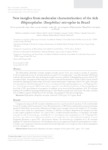Por favor, use este identificador para citar o enlazar este ítem:
http://www.alice.cnptia.embrapa.br/alice/handle/doc/1061159Registro completo de metadatos
| Campo DC | Valor | Lengua/Idioma |
|---|---|---|
| dc.contributor.author | CSORDAS, B. G. | pt_BR |
| dc.contributor.author | GARCIA, M. V. | pt_BR |
| dc.contributor.author | CUNHA, R. C. | pt_BR |
| dc.contributor.author | GIACHETTO, P. F. | pt_BR |
| dc.contributor.author | BLECHA, I. M. Z. | pt_BR |
| dc.contributor.author | ANDREOTTI, R. | pt_BR |
| dc.date.accessioned | 2017-01-18T11:11:11Z | pt_BR |
| dc.date.available | 2017-01-18T11:11:11Z | pt_BR |
| dc.date.created | 2017-01-18 | pt_BR |
| dc.date.issued | 2016 | pt_BR |
| dc.identifier.citation | Revista Brasileira de Parasitologia Veterinaria , Jaboticabal, v. 25, n. 3, p. 317-326, jul./set. 2016. | pt_BR |
| dc.identifier.uri | http://www.alice.cnptia.embrapa.br/alice/handle/doc/1061159 | pt_BR |
| dc.description | The Rhipicephalus (Boophilus) microplus complex currently consists of five taxa, namely R. australis, R. annulatus, R. (B.) microplus clade A sensu, R. microplus clade B sensu, and R. (B.) microplus clade C sensu. Mitochondrial DNA-based methods help Taxonomists when they are facing the morpho-taxonomic problem of distinguishing members of the R. (B.) microplus complex. The purpose of this study was to perform molecular characterization of ticks in all five regions of Brazil and infer their phylogenetic relationships. Molecular analysis characterized 10 haplotypes of the COX-1 gene. Molecular network analysis revealed that haplotype H-2 was the most dispersed of the studied populations (n = 11). Haplotype H-3 (n = 2) had the greatest genetic differentiation when compared to other Brazilian populations. A Bayesian phylogenetic tree of the COX-1 gene obtained strong support. In addition, it was observed that the population of R. (B.) microplushaplotype H-3 exhibited diverging branches among the other Brazilian populations in the study. The study concludes that the different regions of Brazil have R. (B.) microplus tick populations with distinct haplotypes. | pt_BR |
| dc.language.iso | eng | eng |
| dc.rights | openAccess | eng |
| dc.subject | COX-I gene | pt_BR |
| dc.subject | ITS-2 gene | pt_BR |
| dc.subject | Carrapato-do-boi | pt_BR |
| dc.title | New insights from molecular characterization of the tick Rhipicephalus (Boophilus) microplus in Brazil. | pt_BR |
| dc.type | Artigo de periódico | pt_BR |
| dc.date.updated | 2017-03-02T11:11:11Z | pt_BR |
| dc.subject.nalthesaurus | Rhipicephalus microplus | pt_BR |
| dc.subject.nalthesaurus | Ticks | pt_BR |
| dc.subject.nalthesaurus | Brazil | pt_BR |
| riaa.ainfo.id | 1061159 | pt_BR |
| riaa.ainfo.lastupdate | 2017-03-02 | pt_BR |
| dc.contributor.institution | BÁRBARA GUIMARÃES CSORDAS, UFMS; MARCOS VALÉRIO GARCIA, Bolsista CNPGC; RODRIGO CASQUERO CUNHA, UFPEL; POLIANA FERNANDA GIACHETTO, CNPTIA; ISABELLA MAIUMI ZAIDAN BLECHA, UFMS; RENATO ANDREOTTI E SILVA, CNPGC. | pt_BR |
| Aparece en las colecciones: | Artigo em periódico indexado (CNPGC)  | |
Ficheros en este ítem:
| Fichero | Descripción | Tamaño | Formato | |
|---|---|---|---|---|
| Newinsightsfrommoldecular.pdf | 3.28 MB | Adobe PDF |  Visualizar/Abrir |









